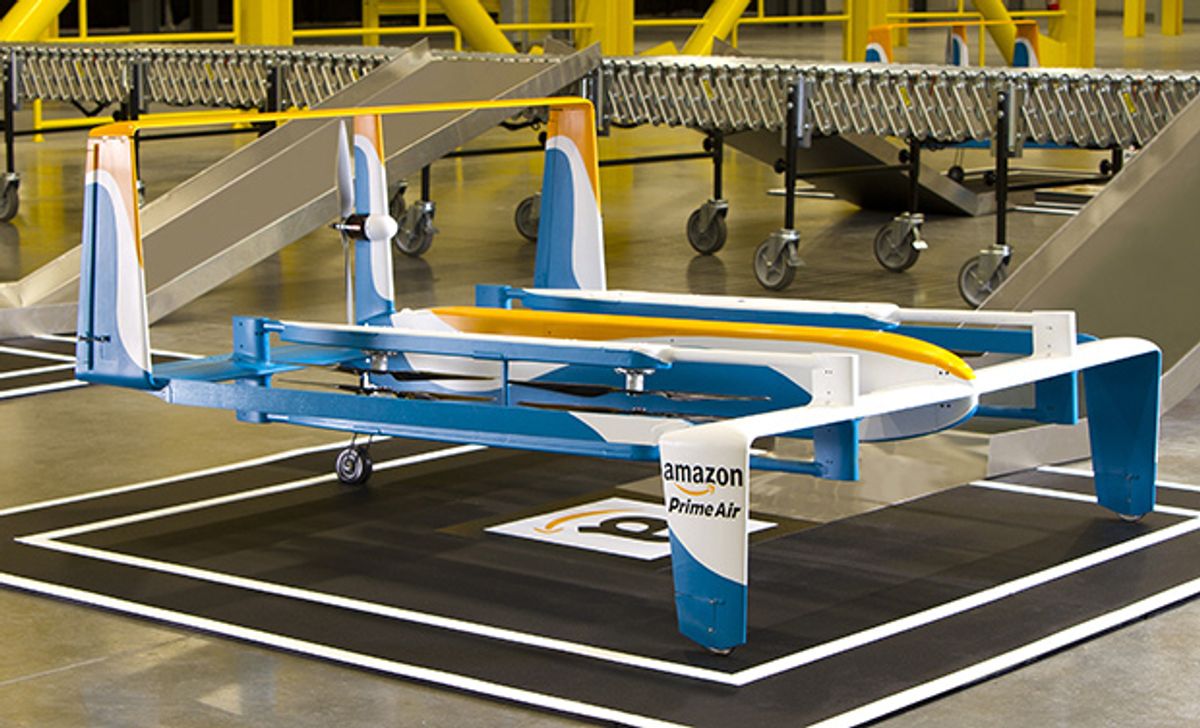Today is Cyber Monday, one of the biggest online shopping days of the year. In what I’m sure is just a coincidence, Amazon has posted a fancy new video of the latest version of their drone that may, one day, they hope, deliver things to you, kinda, maybe. Are we now astounded and impressed and excited and optimistic about the future of urban drone delivery? Not so much, no.
Here’s the video:
What did we learn, besides the fact that Jeremy Clarkson is funnier when he’s improvising? A few things, from the video and the accompanying webpage:
- Amazon has decided that the most efficient drone design for deliveries is a hybrid. This is not surprising; Sony and many others decided the same thing.
- The video says “ACTUAL FLIGHT FOOTAGE,” which suggests that the drone is actually flying. I guess we’re supposed to be impressed by that?
- Now, is the drone in any way autonomous? From the footage, it’s unclear, but there is a quote in the video that does suggest it is: “It knows what’s happening around it. It uses sense and avoid technology to sense, and then avoid, obstacles on the ground and in the air.” Contrast this quote with the information on Amazon’s website: “our vehicles will be built with multiple redundancies, as well as sophisticated ‘sense and avoid’ technology.” I don’t see any sensors on the drone at all, or any evidence that the drone is actually doing sense and avoid, and the language (“will be built with”) suggests that this is a feature that Amazon has not actually implemented. This is sort of like saying, “our vehicles will be built with warp drives and transporters.” Great, let me know when you actually do get that to work, but until then, I’m going to remain just as skeptical as I was before.
- The delivery zone is based around a large fiducial marker. We guessed that this would be one partial solution to the landing problem, but it only tells the drone where it should try to land, and not whether it’s safe to land there. The video says that it “scans the landing area for potential hazards,” but doesn’t go into any detail, and personally I’m more concerned about (say) the dog running over to attack the drone once it’s close to the ground. Also note the amount of space that the drone requires: probably okay for suburbia, maybe not as practical for urban areas, which is where drone delivery would make the most sense from a commercial perspective (and where Amazon clearly wants to fly).
- “Putting Prime Air into service will take some time, but we will deploy when we have the regulatory support needed to realize our vision.” This makes it sound like Amazon is being held back by the FAA. They’re not. Dollars to donuts the FAA is going to have drone delivery regulated waaay before anyone is ready to (safely) attempt it autonomously in an urban environment.
Amazon provides links to their suggestions for how public airspace should be set up for drones in the near future. Here’s what it looks like:
The “low-speed localized traffic” area is for drones with basic navigation software and hardware, ranging from just direct radio control to a simple autopilot. The “high-speed transit” area is for more sophisticated drones incorporating advanced autopilots and sensors. Amazon breaks it down like this:
This is not necessarily an unreasonable way to restrict airspace, but we have to point out that the equipage that Amazon is using to differentiate basic, good, and better drones doesn’t exist yet. We don’t have universal vehicle-to-vehicle communication standards for drones, and we certainly don’t have non-collaborative search-and-avoidance technology. Maybe the right time to implement a framework like this is before all of the tech is already out there, but it seems like Amazon is overreaching just a little bit by suggesting definitions based on technologies that, so far, we have not seen much in the way of tangible progress toward.
The thing that I don't understand is why Amazon and Google and others keep on iterating (and publicizing) these heavy lift designs, because they’re just solving the easy part of the problem first. Given enough money, basically anyone can build a big drone that lifts stuff and flies itself, so the fact that Amazon and Google and all kinds of other companies have done this (and then applied slick paint and decals and made expensive videos) is not the least bit impressive.
What would be impressive is if we saw a demonstration of a boring looking quadrotor with even a bare minimum of autonomous sense-and-avoid technology operating on board. If you can make that work, then by all means, develop a heavy lift drone that can leverage it to do package delivery. But watching all these companies skip over the hardstuff while flashily showing off their incremental progress on the easy stuff isn’t inspiring confidence that anyone has a plan to solve the hard stuff anytime soon.
And you know what the worst part about all this is? We got suckered into doing exactly what Amazon wanted, which is to post an article about Amazon on Cyber Monday. Grrr!
[ Amazon Prime Air ]
Evan Ackerman is a senior editor at IEEE Spectrum. Since 2007, he has written over 6,000 articles on robotics and technology. He has a degree in Martian geology and is excellent at playing bagpipes.






